Change can be a good thing. Just ask the glaucoma department at the Cincinnati Eye Institute (CEI). To accommodate a growing number of glaucoma patients and a lack of staff coverage, the glaucoma department recently transitioned from its traditional doctor-team staffing model, where the allied health staff were assigned to work with a specific physician, to a shared staffing model. This switch has been a win-win-win, benefitting doctors, staff, and patients alike.
Here, the CEI glaucoma department staff discuss the benefits of shared staffing and the specific steps the department took to implement this model.
Benefits impact efficiency, patient care, and the staff
“The biggest impact of the shared-staffing model has been the decrease in patient wait times,” explains Kerry McGehee, vice president of operations at the 70-year-old practice that has locations in Ohio, Kentucky, and Indiana. “With the doctor-team staffing model, the patient had to wait for their doctor’s tech to pick them up to perform their workup. With the shared-staffing model, the patient is almost immediately picked up for their workup by whichever tech is free at that moment. This has also benefitted our doctors, who used to have to wait for their patients to be worked up by their personal techs.”
A reduction in patient times as it relates to a practice’s sustainability is significant. Specifically, data show 30% of patients have left their appointment, and one in five have changed doctors due to long wait times, according to Vitals.com , an online database of patient reviews for doctors and facilities.
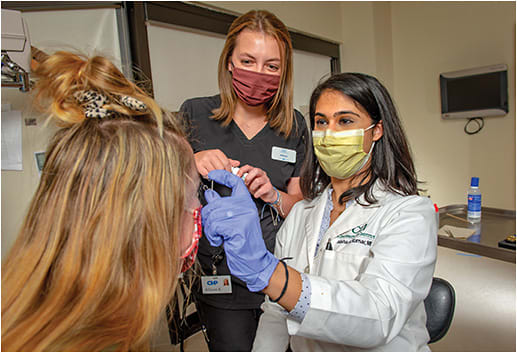
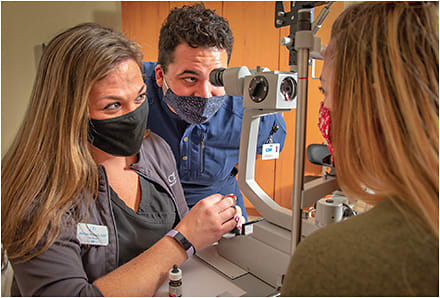
Fred Chu, MD, CEI’s director of glaucoma service, notes the shared-staffing model has plugged staffing holes — the result of illness or vacation days.
The shared-staffing model also has increased morale, camaraderie, and work enjoyment among the staff, says Josh Kaiser, COA, a tech in CEI’s glaucoma department.
“Some doctors see more or less patients than others, so under the doctor-team staffing model, the workload among the techs was unbalanced. Now, everyone has about the same workload, which has raised staff morale,” he offers. “Also, the shared-staffing model has allowed for more teamwork because there are more people to work with, and it has opened the door to working with doctors we didn’t get to work with before and meeting different patients. I think this makes coming to work more interesting.”
Jennifer Sommer, a scribe and technician in the practice’s glaucoma department, adds that the shared-staffing model feels less stressful, specifically in instances where a patient workup may take a little extra time. She says she no longer worries about the next patients waiting, because one of her colleagues will keep things moving.
Amy Jost, who oversees CEI’s education department and helped facilitate the change in staffing models, acknowledges that the glaucoma department’s staff was initially apprehensive about leaving the doctors they solely worked with. But, they have come to realize that they are able to continue that rapport while creating connections with other doctors and fellow staff members.
Implementation: Begin with a standardized workup
In planning for the shared-staffing model, the CEI glaucoma department recognized that each doctor had their own way of working up a glaucoma patient. With nine ophthalmologists who specialize in glaucoma, and six optometrists who work with them, it became evident that a standardized workup would be needed for the new staffing model to succeed. This was the first step in making the switch. (See “Tips for Success,” below.)
“We knew it would be really inefficient for our technicians to fill in on other doctor teams because they wouldn’t know how those doctors wanted things done,” explains Aubrey Tirpack, MD, one of CEI’s glaucoma specialists. “Instead of being able to pop in and know exactly what to do, they’d have to learn on the spot.”
To arrive at a standardized workup, the techs provided all the glaucoma doctors with the individual workup preference sheets and asked them to check the workup items they wanted. From there, they had several meetings with the management team to determine what they could compromise and ultimately agree on, says Dr. Chu.
One change made for the standardized workup: Techs would no longer perform tonometry post-op, notes Ms. Sommer.
“Some of the doctors were very comfortable with their staff checking pressure on a post-glaucoma surgical patient within a week, while others didn’t want the technicians to perform tonometry at all in the 90-day global period,” she points out. “So, the doctors came to the agreement that all glaucoma post-op workups would be within the first 30 days, during which only the doctor would check the pressure.”
Once the glaucoma doctors came to a consensus on the standardized workup, a uniform, step-by-step sheet was provided to all the techs.
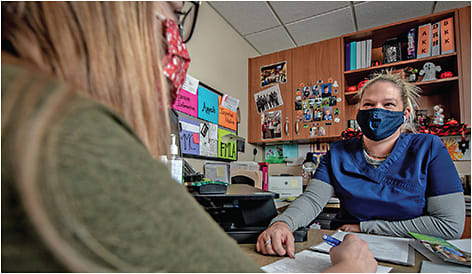
Evaluate staff and train to fill gaps
The second step CEI’s glaucoma department took to institute the shared-staffing model was to perform a skills assessment on the techs to see who required training for the standardized workup, says Mr. McGehee.
“Our objective was to identify who needed help with performing tonometry, pachymetry, and retinal imaging, such as OCT, so all the technicians would be skilled from A to Z to jump in and lend a hand wherever needed,” he explains. “This step also helped balance the workload among the techs, so those techs who had been feeling overworked appreciated that, while those who picked up new skills were also gratified.”
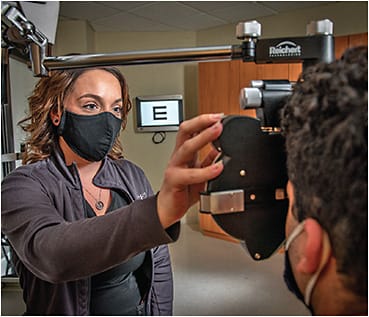
Mr. McGehee stresses that regardless of whether a practice opts for the shared-staffing model, staff training should take precedence in practice management to ensure staff coverage.
“I highly recommend using any downtime on staff training,” he asserts. “And, if that’s not possible, I recommend picking a few days to do it after hours. The sooner you can start to cross-train to where your technicians are basically getting the skill set across the entire spectrum of the workups, the better.”
Ms. Jost adds that the training team is currently conducting skill evaluations on all the practice’s techs and scribes — nearly 300 of them.
Create uniform device use
Once staff training commenced, CEI’s glaucoma department performed an equipment assessment to ensure all 26 of its exam lanes were outfitted with the same devices for efficiency, Mr. McGehee says.These devices: Haag Streit or Zeiss slit lamps, applanation tonometers, Lombart phoropters, M&S vision testing systems, transilluminators, corneal pachymeters, pupil gauges, and near cards.
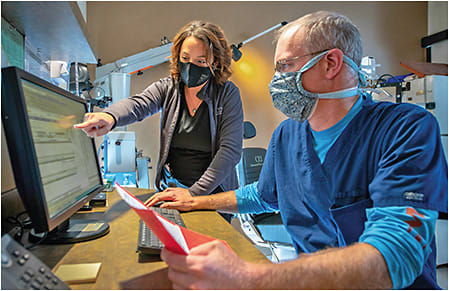
“We wanted all the lanes to be identical, so it didn’t matter if you were a doctor seeing and doing an exam or if you were a technician doing a workup, you had all the equipment necessary to do it right there, and you knew exactly how to operate it,” he explains. “Another benefit of this is that our elderly glaucoma patients no longer have to traverse our entire facility for certain testing.”
TIPS FOR SUCCESS
The staff at CEI’s glaucoma department say the switch from the doctor-team staffing model to the shared model was successful, due to:
- Doctor buy-in. “Once we explained how the shared-staffing model would create a more efficient and productive department, the doctors were quick to understand and buy in to it,” says Mr. McGehee.
- A laser focus on exceptional patient care. Each doctor entered into this with a laser focus on providing the best patient care possible, says Ms. Jost. “That’s how they were able to come to a consensus on the standardized glaucoma workup.”
- Open-mindedness. “I kind of liked having my own doctor, but being open-minded went a long way because it allowed me to see the benefits of the staffing model change,” says Mr. Kaiser.
- Strong communication. Ms. Sommer stresses that a staff pool is only as strong as its weakest tech, so instilling the importance of communication, in terms of ensuring everyone knows what is expected of them and inviting questions, is crucial. “Everyone involved needs to make their voices heard,” she says.
- Restricting tech duties. “This depends on the specific practice, but many practices, and we were one of them, had their technicians performing administrative tasks, such as prescription refills, which are not patient-facing,” says Mr. McGehee. “We carved that out of the technician’s responsibility, and it made a world of difference, efficiency-wise.”
- Adaptation. Ms. Sommer points out that whatever is implemented may not be perfect the first or even the 10th time, but adapting to these challenges by trying new ideas and figuring out what works best for your particular clinic needs is key.
Utilize a facilitator
The final step to implementing the shared-staffing model was putting in place a facilitator, or a clinical manager, whose job is to essentially direct the department’s traffic and keep the techs on task, says Mr. McGehee.
“This person is responsible for the minute-by-minute, hour-by-hour flow of the clinic. They are constantly evaluating patient status, doctor status and tech status within the glaucoma department to prevent bottlenecks,” he explains. “And in identifying bottlenecks, this person can then shift resources to minimize them.”
An example: Although patients are taken in order of their appointment time, should there be a setback that slows the technician and doctor down, such as a high IOP, the clinical manager would shift resources to help identify which patients to take next and which technician should take them in order to continue clinic efficiency in all the other doctors’ clinics.
Ms. Jost says the facilitator has made all the techs more accountable for their time, which has aided to create an even workload.
Expansion
With the prosperity of the shared-staffing model at CEI’s glaucoma department, the practice is now looking to make this switch in its other departments, says Dr. Chu.
“We took on this challenge, and we’ve made it a model for the rest of the practice,” he asserts. “It’s been exciting and great to see that it’s succeeding.” OP








